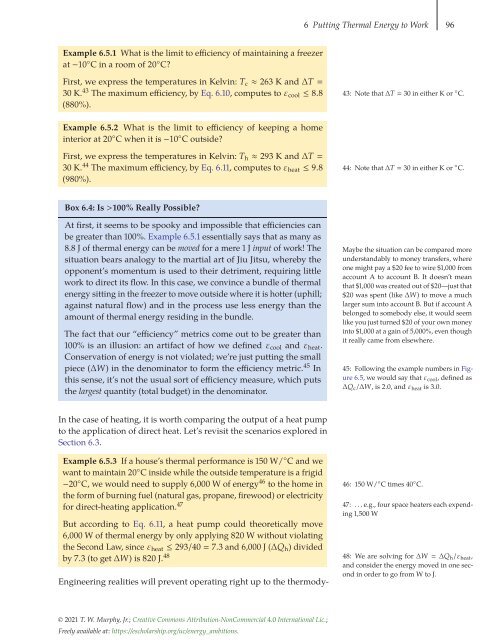Energy and Human Ambitions on a Finite Planet, 2021a
Energy and Human Ambitions on a Finite Planet, 2021a
Energy and Human Ambitions on a Finite Planet, 2021a
You also want an ePaper? Increase the reach of your titles
YUMPU automatically turns print PDFs into web optimized ePapers that Google loves.
6 Putting Thermal <str<strong>on</strong>g>Energy</str<strong>on</strong>g> to Work 96<br />
Example 6.5.1 What is the limit to efficiency of maintaining a freezer<br />
at −10 ◦ C in a room of 20 ◦ C?<br />
First, we express the temperatures in Kelvin: T c ≈ 263 K <str<strong>on</strong>g>and</str<strong>on</strong>g> ΔT <br />
30 K. 43 The maximum efficiency, by Eq. 6.10, computes to ε 43: Note that ΔT 30 in either K or ◦ cool ≤ 8.8<br />
C.<br />
(880%).<br />
Example 6.5.2 What is the limit to efficiency of keeping a home<br />
interior at 20 ◦ C when it is −10 ◦ C outside?<br />
First, we express the temperatures in Kelvin: T h ≈ 293 K <str<strong>on</strong>g>and</str<strong>on</strong>g> ΔT <br />
30 K. 44 The maximum efficiency, by Eq. 6.11, computes to ε 44: Note that ΔT 30 in either K or ◦ heat ≤ 9.8<br />
C.<br />
(980%).<br />
Box 6.4: Is >100% Really Possible?<br />
At first, it seems to be spooky <str<strong>on</strong>g>and</str<strong>on</strong>g> impossible that efficiencies can<br />
be greater than 100%. Example 6.5.1 essentially says that as many as<br />
8.8 J of thermal energy can be moved for a mere 1 J input of work! The<br />
situati<strong>on</strong> bears analogy to the martial art of Jiu Jitsu, whereby the<br />
opp<strong>on</strong>ent’s momentum is used to their detriment, requiring little<br />
work to direct its flow. In this case, we c<strong>on</strong>vince a bundle of thermal<br />
energy sitting in the freezer to move outside where it is hotter (uphill;<br />
against natural flow) <str<strong>on</strong>g>and</str<strong>on</strong>g> in the process use less energy than the<br />
amount of thermal energy residing in the bundle.<br />
The fact that our “efficiency” metrics come out to be greater than<br />
100% is an illusi<strong>on</strong>: an artifact of how we defined ε cool <str<strong>on</strong>g>and</str<strong>on</strong>g> ε heat .<br />
C<strong>on</strong>servati<strong>on</strong> of energy is not violated; we’re just putting the small<br />
piece (ΔW) in the denominator to form the efficiency metric. 45 In<br />
this sense, it’s not the usual sort of efficiency measure, which puts<br />
the largest quantity (total budget) in the denominator.<br />
Maybe the situati<strong>on</strong> can be compared more<br />
underst<str<strong>on</strong>g>and</str<strong>on</strong>g>ably to m<strong>on</strong>ey transfers, where<br />
<strong>on</strong>e might pay a $20 fee to wire $1,000 from<br />
account A to account B. It doesn’t mean<br />
that $1,000 was created out of $20—just that<br />
$20 was spent (like ΔW) to move a much<br />
larger sum into account B. But if account A<br />
bel<strong>on</strong>ged to somebody else, it would seem<br />
like you just turned $20 of your own m<strong>on</strong>ey<br />
into $1,000 at a gain of 5,000%, even though<br />
it really came from elsewhere.<br />
45: Following the example numbers in Figure<br />
6.5, we would say that ε cool , defined as<br />
ΔQ c /ΔW, is 2.0, <str<strong>on</strong>g>and</str<strong>on</strong>g> ε heat is 3.0.<br />
In the case of heating, it is worth comparing the output of a heat pump<br />
to the applicati<strong>on</strong> of direct heat. Let’s revisit the scenarios explored in<br />
Secti<strong>on</strong> 6.3.<br />
Example 6.5.3 If a house’s thermal performance is 150 W/ ◦ C <str<strong>on</strong>g>and</str<strong>on</strong>g> we<br />
want to maintain 20 ◦ C inside while the outside temperature is a frigid<br />
−20 ◦ C, we would need to supply 6,000 W of energy 46 to the home in 46: 150 W/ ◦ C times 40 ◦ C.<br />
the form of burning fuel (natural gas, propane, firewood) or electricity<br />
for direct-heating applicati<strong>on</strong>. 47<br />
47: . . . e.g., four space heaters each expending<br />
1,500 W<br />
But according to Eq. 6.11, a heat pump could theoretically move<br />
6,000 W of thermal energy by <strong>on</strong>ly applying 820 W without violating<br />
the Sec<strong>on</strong>d Law, since ε heat ≤ 293/40 7.3 <str<strong>on</strong>g>and</str<strong>on</strong>g> 6,000 J (ΔQ h ) divided<br />
by 7.3 (to get ΔW) is 820 J. 48 48: We are solving for ΔW ΔQ h/ε heat ,<br />
<str<strong>on</strong>g>and</str<strong>on</strong>g> c<strong>on</strong>sider the energy moved in <strong>on</strong>e sec<strong>on</strong>d<br />
in order to go from W to J.<br />
Engineering realities will prevent operating right up to the thermody-<br />
© 2021 T. W. Murphy, Jr.; Creative Comm<strong>on</strong>s Attributi<strong>on</strong>-N<strong>on</strong>Commercial 4.0 Internati<strong>on</strong>al Lic.;<br />
Freely available at: https://escholarship.org/uc/energy_ambiti<strong>on</strong>s.


















